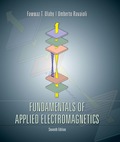
Concept explainers
A plane wave in air with an electric field amplitude of 20 V/m is incident normally upon the surface of a lossless, nonmagnetic medium with ϵr = 25. Determine the following:
- (a) The reflection and transmission coefficients.
- (b) The standing-wave ratio in the air medium.
- (c) The average power densities of the incident, reflected, and transmitted waves.
(a)
The reflection coefficient
Answer to Problem 1P
The reflection coefficient
Explanation of Solution
Given data:
The electric field amplitude
The permittivity
Calculation:
The reflection coefficient
Here,
Write formula to find intrinsic impedance.
Here,
So, find intrinsic impedance of the medium
Hence,
Here,
Substitute
Now, find intrinsic impedance of medium 2.
Here,
Substitute
Substitute
The transmission coefficient
Here,
Substitute
Conclusion:
Therefore, the reflection coefficient
(b)
The standing-wave ratio
Answer to Problem 1P
The value of standing-wave ratio
Explanation of Solution
The calculated value of reflection coefficient
Calculation:
The standing-wave ratio is given by,
Here,
Substitute
Conclusion:
Therefore, the value of standing-wave ratio
(c)
The average power density of the incident
Answer to Problem 1P
The value of average power density of the incident wave
Explanation of Solution
Given data:
The electric field amplitude
The calculated value of intrinsic impedance of air
The calculated value of reflection coefficient
Calculation:
The average power density of the incident
Here,
Substitute
The average power density of the reflected
Substitute
The average power density of the transmitted
Substitute
Conclusion:
Therefore, the value of average power density of the incident wave
Want to see more full solutions like this?
Chapter 8 Solutions
Fundamentals of Applied Electromagnetics (7th Edition)
- Need handwritten solution not using chatgptarrow_forwardHandwritten Solution pleasearrow_forwardThe E-field pattern of an antenna. independent of , varies as follows: E 0 0° ≤ 0≤ 45° 45°<≤ 90° 90° <8180° (a) What is the directivity of this antenna? Umax 7 why did we use this law Umax = 12 but we divided by 2? In the sent Solution = R 27arrow_forward
- The normalized far-zone field pattern of an antenna is given by (sin cos²) E = 0 00 and 0 ≤ ≤ π/2. 3/22 π elsewhere Find the directivity using (a) the exact expression In the sent soalation Use Prad=2+1 7/2 Pre= 2 + 1 Sco³odo + 5 siño de Where did the 2 Com from?arrow_forwardPen and paper solution please with explaination not using chatgptarrow_forwardhowarrow_forward
- A four pole generator having wave wound armature winding has 51 slots ,each slot containing 20 conductors,what will be the voltage generated in the machine when driven at 1500rpm assuming the flux per pole is 7mWb Don't use Artificial intelligencearrow_forwardNeed Handwritten solution Do not use chatgpt Or AIarrow_forwardI need a detailed solution to a problem. The far-zone electric field intensity (array factor) of an end-fire two-element array antenna, placed along the z-axis and radiating into free-space, is given by E=cos (cos - 1) Find the directivity using (a) Kraus' approximate formula (b) the DIRECTIVITY computer program at the end of this chapter Repeat Problem 2.19 when E = cos -jkr 0505π $[ (cos + 1) (a). Elmax = Cost (case-1)] | max" = 1 at 8-0°. 0.707 Emax = 0.707.(1) = cos [(cose,-1)] (cose-1) = ± 0,= {Cos' (2) = does not exist (105(0)= 90° = rad. Bir Do≈ 4T ar=2() = = Bar 4-1-273 = 1.049 dB T₂ a. Elmax = cos((cose +1)), 0.707 = cos (Close,+1)) = 1 at 6 = π Imax (Cose+1)=== G₁ = cos(-2) does not exist. Girar=2()=π. 4T \cos (0) + 90° + rad Do≈ = +=1.273=1.049dB IT 2arrow_forward
- I need an expert mathematical solution. The E-field pattern of an antenna. independent of , varies as follows: 0° ≤ 0≤ 45° E = 0 45° {1 90° 90° < 0 ≤ 180° (a) What is the directivity of this antenna? (b) What is the radiation resistance of the antenna at 200 m from it if the field is equal to 10 V/m (rms) for Ø = 0° at that distance and the terminal current is 5 A (rms)?arrow_forwardI need an expert mathematical solution. The normalized far-zone field pattern of an antenna is given by E = {® (sin cos)/ 0 Find the directivity using 0 ≤ 0 ≤ π and 0≤ 0≤ π/2. 3m2sds2, elsewherearrow_forwardI need an expert mathematical solution. The radiation intensity of an aperture antenna, mounted on an infinite ground plane with perpendicular to the aperture. is rotationally symmetric (not a function of 4), and it is given by sin (7 sin 0) U π sin Find the approximate directivity (dimensionless and in dB) usingarrow_forward
 Introductory Circuit Analysis (13th Edition)Electrical EngineeringISBN:9780133923605Author:Robert L. BoylestadPublisher:PEARSON
Introductory Circuit Analysis (13th Edition)Electrical EngineeringISBN:9780133923605Author:Robert L. BoylestadPublisher:PEARSON Delmar's Standard Textbook Of ElectricityElectrical EngineeringISBN:9781337900348Author:Stephen L. HermanPublisher:Cengage Learning
Delmar's Standard Textbook Of ElectricityElectrical EngineeringISBN:9781337900348Author:Stephen L. HermanPublisher:Cengage Learning Programmable Logic ControllersElectrical EngineeringISBN:9780073373843Author:Frank D. PetruzellaPublisher:McGraw-Hill Education
Programmable Logic ControllersElectrical EngineeringISBN:9780073373843Author:Frank D. PetruzellaPublisher:McGraw-Hill Education Fundamentals of Electric CircuitsElectrical EngineeringISBN:9780078028229Author:Charles K Alexander, Matthew SadikuPublisher:McGraw-Hill Education
Fundamentals of Electric CircuitsElectrical EngineeringISBN:9780078028229Author:Charles K Alexander, Matthew SadikuPublisher:McGraw-Hill Education Electric Circuits. (11th Edition)Electrical EngineeringISBN:9780134746968Author:James W. Nilsson, Susan RiedelPublisher:PEARSON
Electric Circuits. (11th Edition)Electrical EngineeringISBN:9780134746968Author:James W. Nilsson, Susan RiedelPublisher:PEARSON Engineering ElectromagneticsElectrical EngineeringISBN:9780078028151Author:Hayt, William H. (william Hart), Jr, BUCK, John A.Publisher:Mcgraw-hill Education,
Engineering ElectromagneticsElectrical EngineeringISBN:9780078028151Author:Hayt, William H. (william Hart), Jr, BUCK, John A.Publisher:Mcgraw-hill Education,





